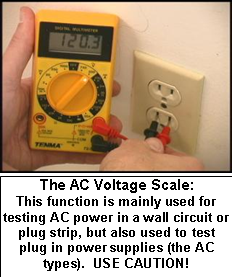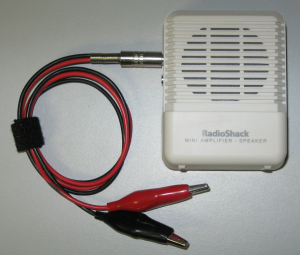Basic Audio Test Equipment
This Basic Audio Test Equipment menu section will cover the very basics of describing the test equipment used for audio related systems. Once you learn about the basics of what this test equipment does, you will be able to perform simple tests and measurements needed to keep your gear up and running. Learning to troubleshoot problems quickly and efficiently will save you time, and money.
Actual Tests and Measurements are covered in more detail on our Basic Tests and Measurements menu page – Click Here!
The Multi-meter
The Multi-meter (also called VOM – Volt/Ohm/Meter) is a very important piece of test gear that any musician cannot do without. With the Multi-meter you can perform the following tests (and more).
- Measure DC voltages – Batteries, plug in power supplies, etc
- Also Measure Speaker resistance – find out if your speaker is open, shorted, or good.
- Measure AC voltage – make sure you have power in the receptacle you plug your equipment into.
- Check all types of cables, fuses, microphones, etc
- Check electronic components such as resistors and diodes.
A Basic Multimeter Breakdown
LCD Display – This displays the measurements that you make on the meter.
a) DC Voltage Scale – Used to check DC power sources such as batteries (all types), and plug in type power supplies.
Symbol for DC =
b) Ohms / Resistance Scale – Used to check cables for opens or shorts, speakers, fuses, etc. Used a lot in audio measurements.
Symbol for Resistance =
c) Diode Checker Scale – Used to check diodes.
Symbol for a Diode =
d) 20 AMP Scale – Used by Electricians to check high currents in house wiring, etc. Not used in Audio Testing. CAUTION – DO NOT USE THIS SCALE FOR ANY REASON!
e) AMP Current Scale – Since we will not use this scale, it will not be covered in this booklet.
f) AC Voltage Scale – Used to check AC power sources such as power to your amplifier, etc. Be very careful and use extreme caution when testing AC! AC can be very dangerous!
Symbol for AC =
g) Scale Selector Switch – This is the switch you turn to the appropriate setting prior to taking measurements. CAUTION: Always make sure you have it on the correct scale setting before taking a measurement or you could damage your meter.
h) Meter Leads – The leads are usually Red and Black. Red is for the “Positive” ( + ) side of any measurements, and the Black is for the “Negative” ( – ) side of any measurements.
Examples of Multi-meter Functions used in Audio…
Let’s look at the three main Multi-meter “functions” that you will be using 95% of the time…
1) DC Voltage Scale
How to Test a 9-Volt Battery (any battery) – Video Clip!
2) Ohms Scale
How to Test a Speaker (any kind of speaker) – Video Clip!
3) AC Voltage Scale
Notes on Multi-meters
Multi-meters come in various sizes, shapes, and can be cheap ($28-$42 range – pictured above) or expensive ($75-$900 range). The cheaper meters are usually calibrated when they are manufactured, but most of the real expensive meters can be sent back to the factory for re-calibration. For basic and / or intermediate audio technical measurements there is really no need for a very expensive meter (but you don’t want to go too cheap either). Also, make sure to take a look at the manual that comes with your meter – you may be able to learn additional information about the meter before you start using it.
The “Mini-Amp” Audio Tester (Powered Speaker)
This section will cover the “Mini-Amp” tester (a basic audio tester that used to be sold at Radio Shack – currently discontinued). Any powered speaker tester will work with the tests described below. This Mini-Amp tester can be used to test speakers, microphones, inputs and outputs, etc. It is very easy to use, is very inexpensive, and can quickly identify where a problem is – or ensure that there is no problem. Learning to troubleshoot problems quickly and efficiently will help save you time, and money. If you don’t have a powered speaker tester – you need to see about getting one (a must for all audio technicians).
The Inputs (located on the left side of tester):
1. INPUT – this is where you plug in your test cable.
2. EXT SPKR – this is where you can plug in an external speaker.
3. DC 9V – this is where you can plug in a DC power supply instead of using a battery.
The Volume Control (located on the upper right side of the tester):
Although this is a basic volume control it is very important to always start with the control at a lower level (start low, bring the volume up as you need it) – starting too high can cause distortion (and give you an incorrect measurement).
Here an example of a test that this mini powered speaker tester can do:
Testing a Microphone with a Powered Speaker – Video Clip
 |
CHECK OUT OUR NEW “TECHNICAL” PUBLICATIONS NOW! |
 |
Cable Testers:
There are many inexpensive “Cable Testers” on the market, here is one example.
Whirlwind Cable Tester
This inexpensive piece of audio test equipment is an easy to use cable tester from Whirlwind which tests all kinds of cables such as Microphone cables, 1/4″ mono, and 1/4″ stereo (TRS), Speaker cables, and RCA cables.
Also the testing of many combinations of cables:
XLR (male or female) to 1/4” Stereo (TRS), 1/4” mono to RCA, RCA to XLR (male or female), 1/4″ mono to XLR (male or female), etc.
Several built in indicators will let you know if Pin 2 or Pin 3 is “Hot” and if any of the leads are reversed. A very useful tool… Cable Tester Video Clip – Here!
In Basic Audio Test Equipment we only covered three basic, but widely used pieces of audio test equipment on this web page. This inexpensive equipment can be used for basic audio troubleshooting and measurements (for the musician that can’t afford the expensive test equipment). Why buy a $300 Multi-meter that will do the same thing as a $45 Multi-meter? There are hundreds of different types and models of audio test equipment out there, so if you are interested in taking your technical knowledge to the next step – look for other resources to increase your audio troubleshooting skills.
Actual Tests and Measurements are covered in more detail on our Basic Tests and Measurements menu page – Click Here!










